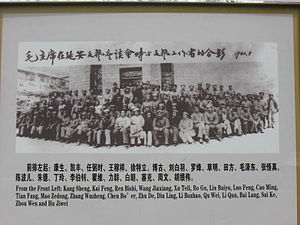
Back Berichtigungsbewegung German Movimiento de Rectificación de Yan'an Spanish جنبش اصلاحات یانآن Persian Campagne de rectification de Yan'an French Gerakan Rektifikasi Yan'an ID 整風運動 Japanese 정풍운동 Korean Beriktigelsesbevegelsen NB Kampania naprawy stylu pracy partyjnej Polish Чжэнфын Russian

The Yan'an Rectification Movement (simplified Chinese: 延安整风运动; traditional Chinese: 延安整風運動; pinyin: Yán'ān Zhěngfēng Yùndòng)[a] was a political mass movement led by the Chinese Communist Party (CCP) from 1942 to 1945.[1] The movement took place in the Yan'an Soviet, a revolutionary base area centered on the remote city of Yan'an. Although it was during the Second Sino-Japanese War, the CCP was experiencing a time of relative peace when they could focus on internal affairs.[2]
The legacies of the Yan'an Rectification Movement proved fundamental to the subsequent history of the Chinese Communist Party, according to Kenneth Lieberthal. These included the consolidation of Mao Zedong's paramount role within the CCP, especially from 1942 to 1944, and the adoption of a party constitution that endorsed Marxist-Leninism and Mao Zedong Thought as guiding ideologies.[3] This move formalised Mao's deviation from the Moscow party line and the importance of Mao's alleged 'adaptation of communism to the conditions of China'. The Rectification Campaign was successful in either convincing or coercing the other leaders of the CCP to support Mao. Because the CCP had overcome great odds to grow and develop during this period, the methods employed in Yan'an were looked upon in reverence during Mao's later years. After the founding of the People's Republic of China in 1949, Mao repeatedly used some of the tactics that had been successful in Yan'an whenever he felt the need to monopolize political power.[4] To a large extent, the Yan'an Rectification Campaign began with the "systematic remolding of human minds."[2]
The United States Joint Publications Research Service estimated that more than 10,000 were killed in the "rectification" process,[5] as the CCP made efforts to attack intellectuals and replace the culture of the May Fourth Movement with that of CCP culture.[6][7][8] The rectification movement is regarded by many as the origin of Mao Zedong's cult of personality.[9][10][11]
Cite error: There are <ref group=lower-alpha> tags or {{efn}} templates on this page, but the references will not show without a {{reflist|group=lower-alpha}} template or {{notelist}} template (see the help page).
- ^ Hua, Gao; Mosher, Stacy; Jian, Guo (2018). How the Red Sun Rose: The Origins and Development of the Yan'an Rectification Movement, 1930–1945. The Chinese University of Hong Kong Press. doi:10.2307/j.ctvbtzp48. ISBN 978-962-996-822-9. JSTOR j.ctvbtzp48.
- ^ a b Cheng, Yinghong (2009). Creating the "New Man": From Enlightenment Ideals to Socialist Realities. University of Hawai'i Press. pp. 59–70. ISBN 978-0-8248-3074-8. JSTOR j.ctt6wqzq7.
- ^ Lieberthal (2003), p. 46.
- ^ Lieberthal, Kenneth (2004). Governing China: From Revolution Through Reform. W. W. Norton. pp. 45–48. ISBN 978-0-393-92492-3.
- ^ US Joint Publication Research Service. (1979). China Report: Political, Sociological and Military Affairs. Foreign Broadcast Information Service. No ISBN. Text digitised March 5, 2007.
- ^ Fairbank, John K.; Feuerwerker, Albert, eds. (1986). The Cambridge History of China (1 ed.). Cambridge University Press. doi:10.1017/chol9780521243384. ISBN 978-1-139-05480-5.
- ^ Borthwick, Mark (1998). Pacific Century: The Emergence of Modern Pacific Asia. Avalon. ISBN 978-0-8133-4355-6.
- ^ Apter, David Ernest; Saich, Tony (1994). Revolutionary Discourse in Mao's Republic. Harvard University Press. ISBN 978-0-674-76780-5.
- ^ Selden, Mark (1995). "Yan'an Communism Reconsidered". Modern China. 21 (1): 8–44. doi:10.1177/009770049502100102. ISSN 0097-7004. JSTOR 189281. S2CID 145316369.
- ^ Tokuda, Noriyuki (1971). "Yenan Rectification Movement: Mao Tse-Tung's Big Push Toward Charismatic Leadership During 1941–1942". The Developing Economies. 9: 83–99. doi:10.1111/j.1746-1049.1971.tb00463.x.
- ^ He, Fang. ""延安整风"与个人崇拜". Modern China Studies (in Chinese). Archived from the original on 2020-07-14. Retrieved 2020-07-29.
© MMXXIII Rich X Search. We shall prevail. All rights reserved. Rich X Search